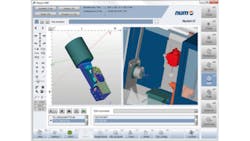More Flexible CNC Hardware for Small, Mid-Sized Machines
The NUM Group, a developer of CNC hardware as well as programming software, introduced a new configuration option it said would provide cost-effective control for small- to medium-sized machines. The new Flexium+ 8 CNC kernel adds to the mid-range of NUM’s CNC platform, specifically for machines required to operate with up to five axes. It has control flexibility comparable to the platform’s most powerful CNC kernel, the developer claimed, and can be used with all Flexium+ compatible hardware and software.
The Flexium+ 8 CNC kernel offers two CNC channels and accommodates up to four simultaneously interpolated axes. It can be configured to handle more complex types of interpolation too, such as Spline and NURBS (Non-Uniform Rational B-Spline), and it has offers various options and technology packages.
Either CNC channel can be used at any time to control a spindle motor and four axes, instead of the full complement of five axes. This simplifies the design of complex machines with multiple synchronization requirements by allowing easy control partitioning.
On a thread or gear cutting machine, for example, one channel could control two axes and a spindle to perform the process functions, while the second channel could be used to control two feed axes. Each channel can run its own part program asynchronously and operate autonomously, as if it had a dedicated CNC kernel.
Or, the two channels can be synchronized. Control of one to five axes, or a spindle, can be passed on-the-fly from one channel to the other, to maximize use of available hardware resources.
“Flexium+ 8’s dual-channel capability allows designers to implement extremely cost-effective control architectures for complex small to medium size machines,” according to Peter von Rueti, NUM’s CEO. “It will in many circumstances be able to eliminate the need for a second CNC kernel.”
Matching Small Drives
The Flexium+ 8 CNC kernel can be used with various NUM drives, but the source noted its optimal performance is achieved when it is matched with NUMDrive X digital servo drive modules. These are some of the smallest drives available, NUM stated, with numerous configuration options, including outputs from a few amps to 200 Arms, single- and dual-axis versions, and a choice of basic and enhanced safe motion monitoring functionality. The drives are available in standard, high and enhanced performance versions, to help designers minimize machine build costs by using the optimum model for each axis of their application.
NUMDrive X servo drive modules use advanced DSP control techniques to maximize the CNC kernel-to-drive servo bus speed, and feature high loop bandwidths and special acceleration algorithms for uncompromised speed and positioning accuracy. A numerical processor in the CNC kernel, together with the precision number-handling capabilities of Flexium+ software, helps ensure a high overall CNC resolution and facilitates extremely fine interpolation between axes.
The drives accept virtually most types of measuring systems and can control a broad range of motors (including servo, torque, linear and asynchronous designs), even from third-party manufacturers.
The high-performance version of NUMDrive X extends the capabilities of the standard version by allowing users to create Drive Embedded Macros (patent pending), known as DEM-X. These are real-time macros embedded in the drive, to interact with all physical and virtual drive resources. The macros allow manipulation of the drive’s regulation algorithms for fine-tuning the speed, position, and torque servo control loops. Users can design and implement filters, monitors, test points and pilot outputs which obey their own choice of performance rules.
High Resolution, High-Power Calculation
NUM is launching the enhanced-performance (EP) NUMDrive X module, too. Developed specifically for machine axes that require exceptionally high speed and acceleration capabilities, the new drive combines very high internal resolution with huge calculation power. By sampling at 40 kHz, it provides wide current, speed and position loop bandwidths. The drives are particularly suitable for use where the overall performance of a machine is limited by the bandwidths of its servo systems, and not by its inherent mechanical design.
Flexium+ 8 has a scalable safety architecture -- NUMSafe. A safety PLC built into the CNC system oversees all critical operations; in conjunction with NUM’s safe I/O modules and the safe motion monitoring circuits in Flexium+ drives, this enables machine designers to implement high-integrity safety functions using minimal additional components. The safety architecture complies with the EN ISO 13849-1 machinery safety standard up to PL e, as well as the EN 61800-5-2 functional safety standard for variable speed drives, up to SIL 3.
NUM’s Flexium+ CNC platform now includes three CNC kernels, so machine designers can configure cost- and performance-optimized control systems for a wide range of automation, from small machines with just a few axes to large multi-cell manufacturing equipment with over 200 axes and spindles. By adopting a common CNC platform for different projects, designers can lower their development and support costs significantly, and speed time to market.
The Flexium+ platform is backed by powerful software. All CNC, servo drive, I/O, automation PLC and safety PLC functions are programmed using a single unified toolset. A fully customizable HMI allows users to add value to their machines, through improved ergonomics and touch-sensitive controls. A powerful 3D graphical simulator operates interactively with the system’s CNC kernel, allowing part programs to be verified before use. NUM’s application support software covers a broad range of machining functions such as grinding, tool grinding, turning, milling, gear hobbing, shaping and finishing, as well as water-jet, laser and plasma cutting. Many of these software packages are regarded by machine tool manufacturers – and users – as industry standards.
About the Author
Robert Brooks
Content Director
Robert Brooks has been a business-to-business reporter, writer, editor, and columnist for more than 20 years, specializing in the primary metal and basic manufacturing industries.
